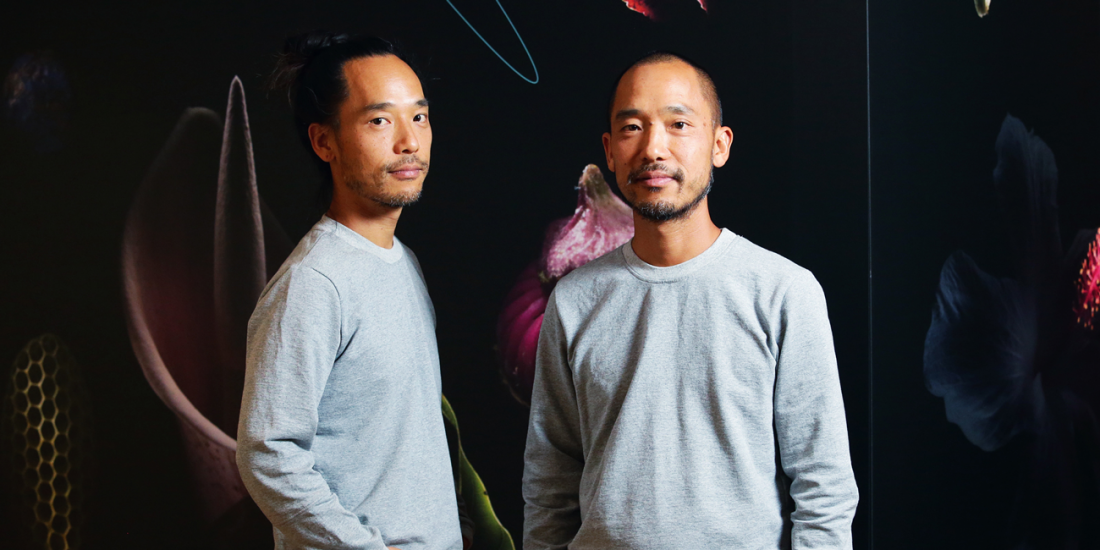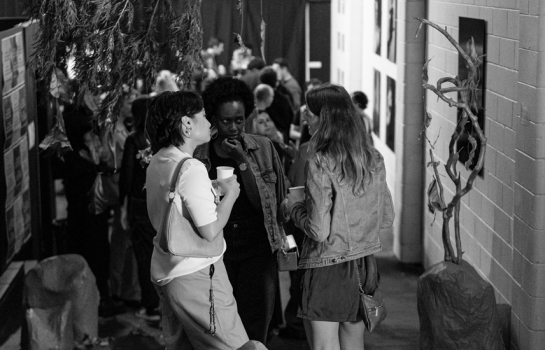Man and Wah, artists, CELESTON 2 at Museum of Brisbane
Exploring and questioning with curiosity for understanding rather than diving directly into assumptions and conclusions is important ...
Although the sheer size of the cosmos and the complexity of nature is something that can be hard to wrap one’s head around, you don’t need a doctorate in astrophysics to appreciate its beauty. Brisbane-based artists Man and Wah aren’t afraid to investigate and explore these topics, celebrating the majesty of our planet’s biodiversity and our place in celestial space via their artistic practice. The twins have exhibited around the globe, showcasing several hyper-detailed video and installation works that reflect on our intrinsic connection to the world around us. Man and Wah spent much of 2020 as artists-in-residence at Museum of Brisbane, spending time creating new works that are currently being showcased in the museum’s gallery spaces. The duo’s newest work, CELESTON 2 is currently on display at Museum of Brisbane, showcasing a mix of audio, video and photographic material that explores the relationship between humans and the universe. We caught up with Man and Wah to chat about their creative process, translating the splendour of the cosmos into art and experiencing art via virtual mediums.
To start, we’d love to know what encouraged you both to embark on artistic careers. Are there any formative experiences that ignited your passion for art, particularly in the audio, video and photographic mediums?
Tracing some of our formative experiences that influenced us in hindsight, it was really the low marks we received after graduating high school that set us on a course of gradual questioning with our imagination, leading us to this point. As two young boys there was just no excitement in attending school and learning. Thinking back on those school days, the curriculum didn’t excite our deep curiosity – for the most part it was instilling conformity rather than creativity. Amongst many other things we much more enjoyed drawing, building legos, lots of nature documentaries, reading comics, riding bikes with friends around the local bushlands and surrounding nature areas, and observing all the insects and animal life in and around our home when they were more abundant.
As twins, did you find you expressed your creativity similarly or differently in your formative artistic pursuits growing up?
Rather than spend time on similarities or differences, we would observe with interest each other’s progress in various mediums, techniques and style which still continues to this day, experiencing each other’s creative perspective and then come up with ways to merge these differences together, which can result in fascinating outcomes. Growing up and
during our formative years for sure we explored and experimented creatively with many mediums and techniques – it is something we both still do. After arriving in Australia, because our English was not so good, we would spend even more time drawing and building things as kids because of the constant forced pressure to learn English. Anything literature related just became a chore. This definitely nudged our creativity towards a more visually inclined imagination. Something probably not so obvious in what we do is that illustrating is a big part of our creativity.
On a similar note, have you always worked together? If not, when did you (and what inspired you to) officially establish this creative pairing?
Officially we decided to work together back in 2015, but in hindsight we both have always ‘unofficially’ worked together creatively in various ways for many years! Although we both lived in different places and had different occupations, we constantly shared what we did creatively and observed each other’s techniques and styles, and this would morph and progress in various ways, then over time when the opportunity presented itself we eased into it gradually.
We’re curious to know how your working partnership operates! What would you say you each bring to the table, where do your ideas and interests typically intersect?
One thing we both enjoy bringing to the table are our homegrown vegetables! Where our ideas and interests intersect is when we are cooking those vegetables (both laugh). But creatively, although we are distinctly different in how we understand and perceive, we have a nice dynamic working rhythm in how we merge and comfortably intersect our interests, creativity and ideas. The art experiences we create is a consequence of that.
Much of your work is inspired by nature and the cosmos – are there any particular aspects of these incredibly deep subjects that inform your art the most?
Nature and the cosmos are both intrinsically connected topics. Being interested in one you will naturally have to inquire about the other at some stage and vice versa. Both subjects alone are vast topics to explore, inspiring us equally in many ways – such as using tools, information and knowledge currently available to us in a mindful way to transmit the multi-dimensional experience of the cosmos and nature in a creative way.
You spent most of the COVID-19 lockdown creating as part of Museum of Brisbane’s Artists@Home residency program. One would assume the act of creating art is typically done in isolation, but did the unique circumstances of the pandemic inform and shape the work made during this time in any notable way?
Observing the fast-changing circumstances around the globe in the beginning of the year was interesting. This influenced us in terms of the subject matters we explore and what kind of content we decided to share on social media. It did not influence our creativity as we have a fairly solid creative process and vision already, which is constantly evolving also.
The work undertaken during this residency helped form the foundations for your newest exhibition CELESTON 2. What can you tell us about this work in regards to its inspirations, creation and the message you hope it communicates to audiences?
The MoB Artsist@Home residency program was a good foundation because there were multiple directions of exploration and creation for CELESTON 1. Then being invited by MoB to create works in conjunction with the Ars Electronica Festival was a natural progression – expanding the ideas of CELESTON 1 into CELESTON 2. Being able to take some of those ideas from the digital realm and into the physical space at MoB was exciting.
CELESTON 2 is being showcased at Museum of Brisbane as part of the Ars Electronica 2020 Festival for Art, Technology & Society. The festival featured a host of works that could be viewed in physical and virtual spaces – what are your thoughts on how viewing and interacting with art in these virtual environments shapes what we take away from art, and the notion of creating works for these digital spaces?
Creating works with MoB for the Ars Electronica Festival was pretty exciting as MoB has a very supportive and amazing team to realise an idea and vision. Also Ars Electronica Festival is an exciting platform, having been around for a long time and often profoundly questioning the role technology plays within this global society. They have been asking these questions for a long time and these questions continue to morph and change along with current times. A great thing about these enquires is it stems from a wide spectrum of disciplines, practices, industries, arts, science and so on, leaving nothing off the table as technology not only touches every aspect of human existence and experience, but greatly affects other life forms, from the macro to the micro, to animals, insects and the natural environment which sustains our life – humans are using technology in some very destructive ways. So being invited to be part of Ars Electronica really aligned with our enquiry into these profound questions.
Arts and creativity in the virtual and digital spaces have its benefits, especially for people that cannot physically experience the works. At the same time there can be limits if the work was not intended for a virtual or digital space and can become a narrow passive viewing experience. It all depends on the context of the work. An example would be CELESTON 2 – let’s say there are individuals who cannot make it to experience the work physically. We can do a walk through by filming the space and it can be passively viewed on a screen on the opposite side of the world by many people. Or another person who experiences the work physically in the space, that individual is exposed to the full sensory experience of what has been created, take their time to observe the details on the large scale cosmic floral wall montage in the foyer that wraps around the corner into a dimly lit ethereal hallway, and it’s all connected by a softly lit electric-blue neon light that guides the viewer to the large scale prints in the hallway. Again the viewer can take their time and observe all the fine details on these metallic prints – such as the planetary elements, florals, insects and geometries. All this is connected by the ambient audio created by space composer Jonn Serrie, which ties the entire foyer and hallway space together for a full sensory immersive experience. Each individual has viewed the art, but its two completely different experiences, so the takeaway is a question – whether it is for a virtual/digital or physical space or the use of technology, will these tools cater for the inclusive wellbeing for all life to thrive and enhance the human experience and existence?
Over the summer you’ll be running a workshop in which you’ll be imparting some wisdom on macro photography and videography. What’s one lesson you learned that helped shape your style or improved your technical proficiency?
Always read the instruction booklet for any tools we use.
Your creative practice is described as an “invitation to slow down and reflect on the interconnectedness between humans and the universe”. With this mantra in mind, what do you think are some positive steps people can take to contribute to the collective healing of the post-pandemic world?
Many terrible events and things were already happening on many levels whether locally, globally, individually or collectively pre-pandemic. The events of the past year just exposed them even more starkly in plain sight. At the same time there is also as much generosity and positivity going around. Exploring and questioning with curiosity for understanding rather than diving directly into assumptions and conclusions is important.
CELESTON 2 is exhibiting now at Museum of Brisbane until April. Man and Wah will be hosting their ‘Botanical Photography’ workshop at the museum on Saturday January 16. You can book tickets here.


